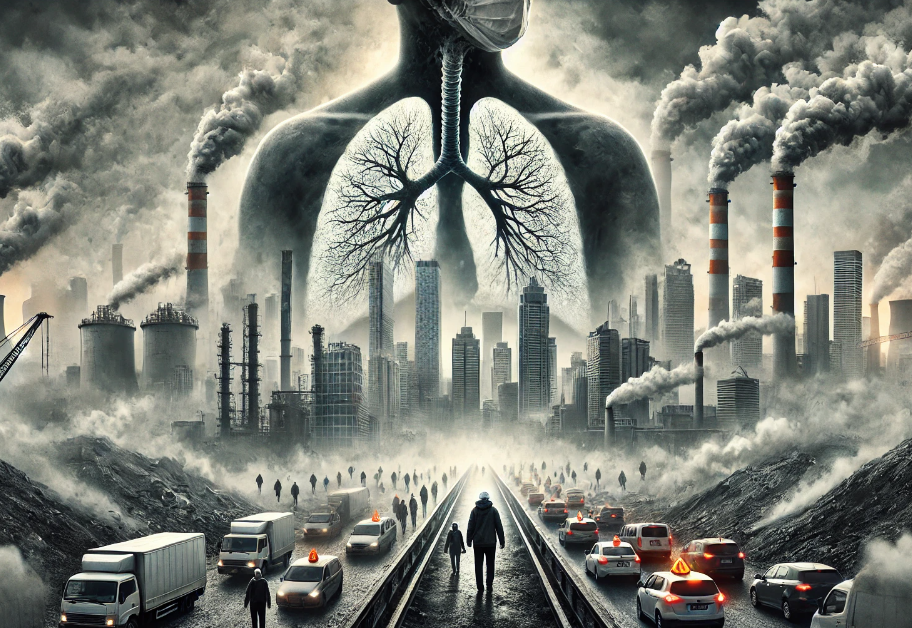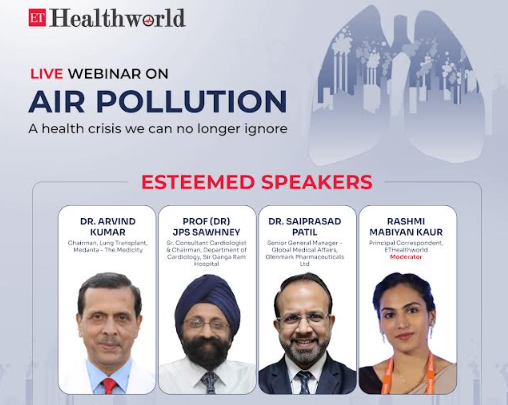
New Delhi : In recent years, Delhi’s skyline has been consistently obscured by a thick layer of smog. While much has been said about the burning of crop residue and vehicular emissions, the true human cost of this pollution is only now beginning to be understood. Renowned chest surgeon Dr Arvind Kumar, Chairman of Lung Transplant at Medanta – The Medicity, describes his daily reality with dismay: “When I open the chest of three or four people, I see blackened lungs inside—even in non-smokers.”
Speaking at the recent ETHealthworld webinar on “Air Pollution: A Health Crisis We Can No Longer Ignore,” Dr Kumar’s account highlights an alarming trend. People who have never smoked in their lives are now showing signs of lung damage typically seen in heavy smokers. The culprit? Persistent exposure to dangerously high levels of particulate matter and other pollutants in the air. Dr. Kumar equates the long-term effect of living in such conditions to a chronic health pandemic—one more lethal and widespread than even COVID-19. “Every year, air pollution kills more people globally than COVID-19 did in its entire duration,” he says.
This unseen yet pervasive threat does not usually appear on death certificates. Heart attacks, strokes, respiratory ailments, and lung cancer often claim the lives of people in polluted cities. But, as Dr Kumar points out, the role of pollution in triggering these conditions is grossly underestimated. “Air pollution acts as an insidious contributor in more than 95 per cent of all chronic disease deaths in our country,” he said.
Prof. (Dr.) JPS Sawhney, Senior Consultant Cardiologist & Chairman, Department of Cardiology, Sir Ganga Ram Hospital, adds that nearly a quarter of all mortalities in India are due to pollution-related diseases. “Air pollution has been directly linked to heart attacks, strokes, heart failure, and even atrial fibrillation,” he explains. These conditions, once attributed solely to lifestyle factors, are now also recognized as pollution-related afflictions. The elderly, as well as those with pre-existing heart conditions, face an increased risk as pollution accelerates the onset of acute heart failure in those with stable heart issues.
Reflecting on his career, Dr. Kumar points to four striking changes since 1988. First, cases of lung cancer have surged. Second, half of these cases involve non-smokers, a demographic increasingly affected by polluted environments. Third, the age of onset has dropped, with more cases emerging among people in their 30s and 40s. Fourth, there has been a marked rise in cases among women. “This alarming trend points to a looming lung cancer epidemic in the next decade,” Dr. Kumar warns.
Pollution’s impact on children and the elderly is particularly dire. Children’s smaller airways make them vulnerable to respiratory issues with even a slight increase in pollution. Using the Poiseuille equation, Dr. Kumar explains that even minor swelling in these tiny airways can significantly obstruct airflow, leading to issues like breathlessness, pneumonia, and asthma. Over time, this can hinder lung development, setting up these children for lifelong respiratory struggles.
Yet, the effects of pollution extend beyond the lungs. Pollutants entering the bloodstream can circulate throughout the body, affecting various organs. As Dr. Kumar notes, children are experiencing brain inflammation, which could explain rising rates of hyperactivity. Alarmingly, conditions such as childhood diabetes and obesity are also being linked to pollutants that disrupt metabolic functions.
Dr Kumar emphasises the dual role of air pollution in both deteriorating public health and accelerating climate change. “Air pollution is one side of the coin, with the other being global warming and the climate crisis,” he explains. This convergence of environmental issues threatens a health crisis of unprecedented scale, necessitating a resilient and adaptable healthcare system. He also advocates for a visible awareness campaign, suggesting that every doctor display a message at their clinic that reads, “In polluted cities, breathing kills.” His call to action underscores the need for collective responsibility among India’s 140 crore citizens.
He also addresses the practical challenges of relying on N95 masks and air purifiers. While these may offer temporary relief, they are hardly feasible for long-term, everyday use. He questions, “Can you wear a mask 24/7, 365 days a year?” Air purifiers, he notes, may be useful for high-risk groups like cancer patients or those with compromised immunity, but he firmly states that they cannot serve as a viable solution to the problem of widespread air pollution. Only a public health approach, targeting the sources of pollution, can effectively mitigate this crisis.
Dr. Saiprasad Patil, Senior General Manager of Global Medical Affairs at Glenmark Pharmaceuticals Ltd., stresses that the healthcare system must evolve to manage this “super-linear” relationship between pollution exposure and its health impacts. Specialized units and professionals trained to treat pollution-induced conditions, from paramedics to expert healthcare providers, are now needed in India’s hospitals.
Air pollution is not only claiming lives but also imposing significant economic costs. Chronic health conditions fostered by pollution contribute to rising absenteeism, increased hospitalization, and heavy reliance on intensive care units, which translates to a high burden on healthcare systems. Dr. Kumar estimates that these hidden costs add up to a sizable percentage of India’s GDP, factoring in both the direct costs of treatment and the productivity lost to premature deaths. He warns that “the cost of inaction will be far greater than the cost of preventive action.”
The conversation around air pollution must shift, moving from viewing it as an environmental issue to recognizing it as a critical public health challenge. The experiences of medical experts reveal that there is no part of the body or society that is untouched by pollution. Tackling this issue with urgency and cooperation is imperative to prevent the loss of more lives to this silent, yet devastating, public health crisis.
Watch full webinar: Air Pollution: A Health Crisis We Can No Longer Ignore












